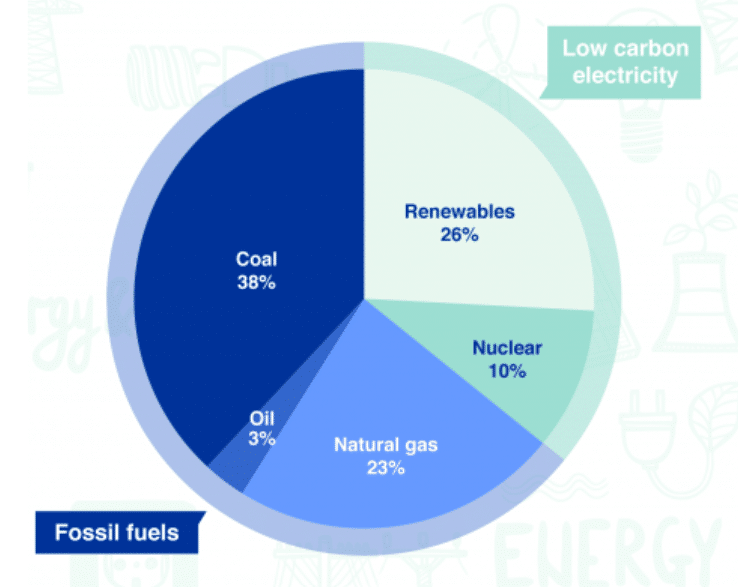No Net Zero Without Uranium: Here’s Why
No Net Zero Without Uranium: Here's Why CarbonCredits.com


Moving Away From Coal With Nuclear Energy
Transitioning from coal to cleaner energy sources is a pivotal step in addressing climate change.
For centuries, coal was the cornerstone of the industrial revolution, but its combustion accounts for over 40% of global carbon emissions. It’s also responsible for 75% of electricity generation emissions in 2019, as per the International Energy Agency (IEA)’s data.
To align with the Paris Agreement’s objectives of curbing global warming below 1.5°C, phasing out coal is imperative.
The shift toward clean energy involves pivoting from high-emission sources to low-carbon alternatives to mitigate climate impacts. This energy transition aims to eliminate reliance on fossil fuels, amplifying renewable options such as hydro, solar, wind, and nuclear power.
An excellent example of this transition is Ontario, which has been coal-free since 2014, primarily harnessing nuclear and hydro energy to power its grid sustainably.
Both coal and nuclear power plants operate using steam-driven turbines to generate electricity. Despite coal accounting for roughly ⅓ of global electricity generation, nuclear energy stands out for its capability to provide consistent baseload power, effectively supplementing intermittent renewable sources like solar and wind.
World Total Electricity Production by Energy Source


Back in 2003, Ontario pledged to phase out a quarter of its electricity generation by decommissioning nearly 9000 MW of coal capacity. To achieve this, the province refurbished nuclear units and integrated a mix of renewables and natural gas. Doing so allowed the Canadian province to successfully attain over 90% carbon-free electricity.
It’s a testament to the feasibility of transitioning away from coal toward cleaner, more sustainable energy sources like nuclear.
The adaptability of nuclear power plants in adjusting output according to demand and the availability of other energy sources adds resilience and stability to the grid, particularly in supporting variable renewables.
The recent report by the United States’ Department of Energy on nuclear power highlighted the potential to convert over 250 GW of coal capacity in the U.S. into nuclear power, effectively doubling the existing nuclear capacity.
Moreover, the DOE’s analysis revealed various benefits for communities near the coal plants considering such a transition. This includes the creation of 650 jobs, generating $275 million in economic activity, and an 86% reduction in GHG emissions.
Deputy secretary, Andrew Griffith, noted that the expertise and skills learned from operating coal plants could be adapted to nuclear power. He further underlined that this potential extends beyond just integrating into the electricity grid, as some reactor concepts can also offer applications in industrial heat.
The agency also emphasized the
SDGs, Targets, and Indicators
SDGs Addressed or Connected to the Issues Highlighted in the Article:
- SDG 7: Affordable and Clean Energy
- SDG 9: Industry, Innovation, and Infrastructure
- SDG 13: Climate Action
Specific Targets Under Those SDGs Based on the Article’s Content:
- SDG 7.2: Increase substantially the share of renewable energy in the global energy mix
- SDG 7.3: Double the global rate of improvement in energy efficiency
- SDG 9.4: Upgrade infrastructure and retrofit industries to make them sustainable
- SDG 13.2: Integrate climate change measures into national policies, strategies, and planning
- SDG 13.3: Improve education, awareness-raising, and human and institutional capacity on climate change mitigation, adaptation, impact reduction, and early warning
Indicators Mentioned or Implied in the Article:
- Carbon dioxide emissions reduction
- Reduction in global carbon emissions
- Percentage of electricity generation from low-carbon sources
- Reduction in greenhouse gas emissions
- Number of jobs created in the energy sector
- Economic activity generated by the energy transition
Table: SDGs, Targets, and Indicators
| SDGs | Targets | Indicators |
|---|---|---|
| SDG 7: Affordable and Clean Energy | 7.2: Increase substantially the share of renewable energy in the global energy mix | Percentage of electricity generation from low-carbon sources |
| SDG 9: Industry, Innovation, and Infrastructure | 9.4: Upgrade infrastructure and retrofit industries to make them sustainable | Reduction in greenhouse gas emissions |
| 9.4: Upgrade infrastructure and retrofit industries to make them sustainable | Number of jobs created in the energy sector | |
| SDG 13: Climate Action | 13.2: Integrate climate change measures into national policies, strategies, and planning | Carbon dioxide emissions reduction |
| 13.3: Improve education, awareness-raising, and human and institutional capacity on climate change mitigation, adaptation, impact reduction, and early warning | Economic activity generated by the energy transition |
Explanation:
– The article discusses the importance of transitioning from coal to cleaner energy sources to address climate change, which aligns with SDG 7 (Affordable and Clean Energy).
– The targets identified under SDG 7 are related to increasing the share of renewable energy in the global energy mix and improving energy efficiency.
– The article also highlights the need to upgrade infrastructure and retrofit industries to make them sustainable (SDG 9: Industry, Innovation, and Infrastructure).
– Under SDG 9, the targets identified are reducing greenhouse gas emissions and creating jobs in the energy sector.
– The integration of climate change measures into national policies and the importance of education and awareness on climate change align with SDG 13 (Climate Action).
– The targets under SDG 13 include reducing carbon dioxide emissions and promoting economic activity in the energy transition.
Behold! This splendid article springs forth from the wellspring of knowledge, shaped by a wondrous proprietary AI technology that delved into a vast ocean of data, illuminating the path towards the Sustainable Development Goals. Remember that all rights are reserved by SDG Investors LLC, empowering us to champion progress together.
Source: carboncredits.com

Join us, as fellow seekers of change, on a transformative journey at https://sdgtalks.ai/welcome, where you can become a member and actively contribute to shaping a brighter future.







